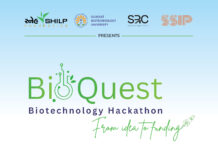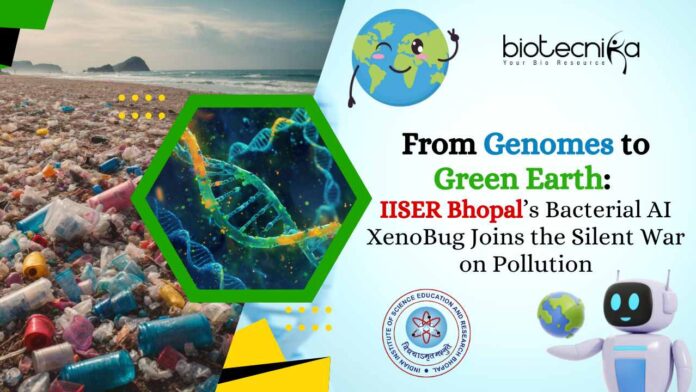IISER Bhopal Bacterial AI XenoBug Joins the Silent War on Pollution
In a world grappling with rising pollution from industrial growth and urbanisation, there’s finally a ray of hope. With the excessive use of synthetic chemicals, like plastics, pesticides, and industrial waste, our environment has borne the burden of poor waste management for decades. Traditional cleanup methods, although effective, often require expensive equipment, time-consuming lab work, and skilled manpower. But what if we could predict nature’s solution—bacterial enzymes—with a few clicks?
That’s precisely what a pioneering team of researchers at the Indian Institute of Science Education and Research (IISER), Bhopal, set out to achieve. Their innovative solution, XenoBug, is a powerful web-based tool designed to predict Bacterial Metabolic Enzymes capable of breaking down pollutants. By utilizing the capabilities of Machine Learning, Neural Networks, and Chemo-informatics, the tool represents a significant leap forward in the field of environmental Biotechnology.
Led by Professor Vineet Sharma from the Department of Biological Sciences, along with Dr. Aditya S. Malwe and Usha Longwani, the IISER-Bhopal team has created an accessible, data-driven system that simplifies the complex world of bioremediation. Their findings have been published in the Nucleic Acids Research Genomics and Bioinformatics (2025) journal.
At the core of XenoBug is a massive, integrated database comprising:
- Over 3.3 million enzyme sequences from environmental metagenomes
- Around 16 million enzymes extracted from more than 38,000 bacterial genomes
- A training set of 6,814 curated enzyme substrates, selected from established biochemical databases like KEGG, MetaCyc, and BRENDA
These enzyme-substrate pairs are annotated with their reaction mechanisms, substrate specificity, and structural features, which help train the machine learning models for precise predictions.
The system functions through three smart modules, each built on robust computational pipelines:
- Module 1: Uses dual multilabel classifiers, such as Random Forests and Support Vector Machines, to assign pollutants to their most probable broad reaction classes (e.g., oxidation-reduction, hydrolysis, transferase reactions).
- Module 2: This module extends the predictions by using six specialized multilabel classifiers, trained on molecular fingerprints like MACCS and ECFP6, to assign specific reaction subclasses and identify finer biochemical steps.
- Module 3: It applies structural similarity searches using tools such as the Tanimoto coefficient, comparing the query pollutant’s chemical structure with a library of known enzymatic substrates to generate full-scale reaction pathway predictions, including EC numbers, cofactors involved, and potential metabolic by-products.
These tools together empower scientists to uncover microbial degradation pathways, identify the bacterial groups responsible, and design targeted bioremediation strategies—quickly, affordably, and with a high degree of confidence. For instance, if a chemical structure is input into XenoBug, the platform can predict whether certain enzymes like monooxygenases, laccases, or dehydrogenases from soil bacteria such as Pseudomonas, Bacillus, or Rhodococcus could potentially degrade it, and through what enzymatic pathway.
What sets XenoBug apart is not just its technological sophistication, but its real-world utility. It covers a wide array of pollutants, including:
- Persistent Organic Pollutants (POPs) like polychlorinated biphenyls (PCBs)
- Pharmaceutical residues such as antibiotics and analgesics
- Agricultural pesticides, including organophosphates and carbamates
- Industrial chemicals such as polyaromatic hydrocarbons (PAHs), phenols, dyes, and plastic polymers like PET and PVC
The platform also includes a bacterial prioritisation module based on enzyme abundance, substrate range, and prior experimental validation. This module enables users to focus on eco-efficient bacterial strains that can survive and perform in contaminated environments.
Professor Vineet Sharma explains, “XenoBug accelerates the identification of suitable Bacterial strains for Bioremediation, reducing both time and costs involved in laboratory testing. It empowers Environmental Scientists with reliable, data-backed predictions that previously took months of laboratory work to uncover.
The impact of this innovation reaches far beyond academic research. With global environmental pollution becoming an urgent crisis, especially in the context of climate change, food security, and public health, tools like XenoBug provide a timely, scalable, and cost-effective way to tackle contamination. It aligns with the goals of the UN Sustainable Development Goals (SDGs), particularly Goal 6 (Clean Water and Sanitation), Goal 13 (Climate Action), and Goal 15 (Life on Land).
By predicting how nature’s own microbes can be mobilised to degrade hazardous pollutants, it opens the door to a cleaner, more sustainable future. Moreover, it reduces reliance on harsh chemical treatments or expensive mechanical remediation systems, encouraging a more ecological and regenerative approach to environmental management.
In a time when environmental despair often dominates headlines, XenoBug stands as a beacon of scientific optimism, showing us that with the right tools and collaborative innovation, we can repair what’s broken. As researchers continue to refine and expand this platform by integrating field-specific microbial isolates, metagenomic samples, and even climate-specific parameters, there’s real hope that polluted lands and waters could soon breathe new life, powered by the invisible, intelligent work of bacteria—and the scientists who believe in their potential.























